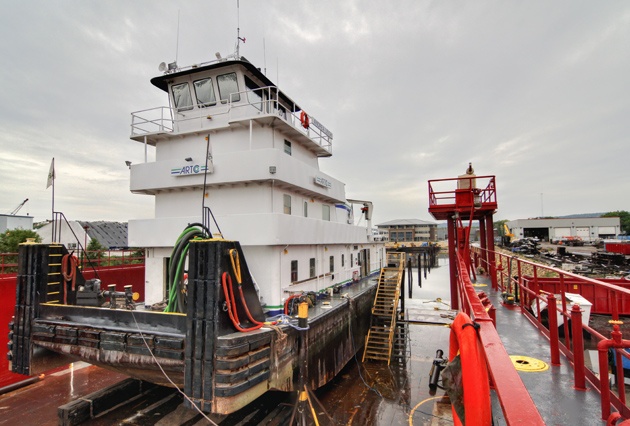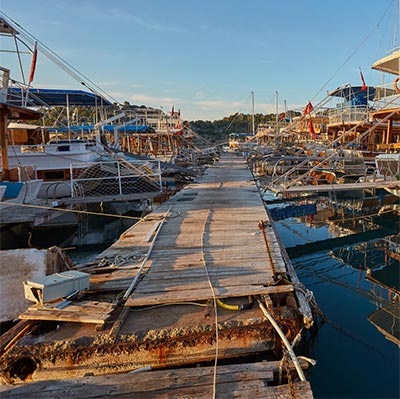Just How to Address Common Dock Repair Work Issues for Safe Water Activities

Identifying Common Dock Issues
Identifying common dock problems is crucial for preserving the performance and safety of your waterside building. Routine evaluations can help uncover issues prior to they end up being serious, guaranteeing both the long life of the dock and the safety of those that use it. One prevalent concern is rusty or loose bolts. Over time, screws, bolts, and various other bolts can become loosened because of consistent exposure to water and weather condition aspects, causing structural instability.
One more usual trouble is the destruction of flotation protection devices. These gadgets are important for keeping the dock resilient, and any damages or punctures can cause the dock to listing or sink. Routinely looking for leakages or waterlogged drifts can preempt extra significant issues.
Additionally, algae and barnacle build-up on the dock's surface area can develop unsafe and unsafe problems. This biofouling not only presents a danger to customers but can also accelerate the wear and tear of the dock materials.
Finally, evaluating for signs of corrosion on metal components is crucial. Rust can jeopardize the honesty of the dock's framework, making it hazardous. By regularly recognizing these common dock issues, you can guarantee that your dock stays functional and protected for years ahead.
Repairing Rotting Timber
When resolving the concern of decomposing wood on your dock, it is essential to act promptly to stop further wear and tear. Begin by thoroughly inspecting the entire structure to recognize all affected areas. Utilize a screwdriver to penetrate the timber; if it sinks in conveniently, the timber is most likely deteriorated and requires instant interest.
Be sure to reduce back to healthy and balanced, strong wood, guaranteeing you remove all compromised product. After elimination, treat the continuing to be wood with a timber preservative to protect against future rot.
Following, replace the removed areas with marine-grade lumber or pressure-treated wood, which are extra immune to water damage. Protect the brand-new pieces with stainless-steel or galvanized fasteners to prevent deterioration. Additionally, using a water-proof sealant to the new timber can provide an extra layer of protection.
Protecting Loose Boards
Just how do you ensure your dock continues to be risk-free and functional for all its users? One crucial facet is protecting loosened boards, which can otherwise position considerable hazards. Loosened boards not only enhance the threat of stumbling yet can additionally jeopardize the structural stability of the whole dock.

For reinstallation, make use of galvanized or stainless steel screws, as these products use exceptional resistance to rust in aquatic atmospheres. Ensure the screws are long enough to penetrate deep into the underlying support framework, but not so lengthy that they protrude through the dock's surface area. Pre-drilling pilot holes can aid stop the timber from splitting.
Lastly, maintain a regular examination timetable to recognize and deal with any type view it now of new issues quickly. By safeguarding loosened boards properly, you add to the total safety and security and long life of your dock, making it a reliable system for water tasks.
Maintaining Unsteady Pilings
Making sure the security of unsteady pilings is critical to maintaining a risk-free and useful dock. Unsteady pilings can compromise the whole structure, posturing significant risks to individuals and possibly causing pricey repair work. The primary step in supporting these necessary elements is a complete evaluation. Check out the pilings for signs of rot, damages, or changing. Use a level to look for upright placement and ensure they are driven deep sufficient into the substratum to supply appropriate assistance.
If the pilings are located to be unstable, one effective technique for support is the use of additional bracing. Cross-bracing with dealt with lumber or galvanized steel can considerably improve security. Anchor the dental braces safely to both the pilings and the dock frame to disperse tons equally.

Regular upkeep and routine review of the pilings' security are vital to guaranteeing long-term dock safety and functionality.
Replacing Rusty Hardware
Dealing with unstable pilings is simply one aspect of preserving a dock's stability; an additional vital concern is replacing rusty equipment. In time, exposure to wetness and salt can lead to the oxidation and deterioration of screws, brackets, and bolts, endangering the whole framework's safety and security. Normal inspection for corrosion is necessary, especially after severe climate or seasonal changes.
When corroded hardware is recognized, instant activity is called for. Begin by selecting marine-grade stainless steel or galvanized hardware, both created to stand up to the rough aquatic environment. Ensure that you have see page the suitable devices, such as screwdrivers and wrenches, to securely eliminate the old, rusty items without triggering additional damages to the dock.
After eliminating the corroded equipment, extensively clean the impacted locations to eliminate any type of residual rust or debris. Apply a rust-inhibiting guide to revealed steel surface areas straight from the source prior to installing the brand-new equipment. Tighten all components firmly to stop future loosening, and periodically examine the fittings to guarantee recurring security.
Changing rustic hardware not just extends the dock's life expectancy however additionally significantly improves the security of water tasks. By proactively managing deterioration, you protect both the structure and its users, guaranteeing a satisfying and protected waterfront experience.
Final Thought
Routine examinations and maintenance are crucial to deal with common dock repair concerns and ensure safe water tasks. By identifying and correcting troubles such as rotting timber, loose boards, unstable pilings, and rustic hardware, architectural security and durability can be substantially boosted. The application of marine-grade products and ideal treatments further fortifies the dock against ecological stress factors. Such positive procedures add to the general safety and security and performance of dock structures, promoting a protected atmosphere for water-based tasks.
Making sure the safety and security of water activities hinges significantly on the appropriate maintenance and repair work of docks (Dock Repairs). These devices are essential for maintaining the dock buoyant, and any damages or slits can trigger the dock to list or sink. By consistently recognizing these typical dock problems, you can make certain that your dock continues to be useful and secure for years to come
Making certain the security of unstable pilings is extremely important to preserving a useful and secure dock.Normal examinations and upkeep are essential to deal with typical dock repair work concerns and make certain safe water tasks.